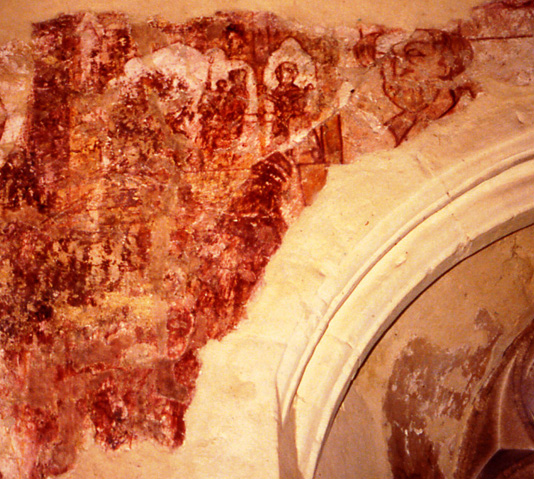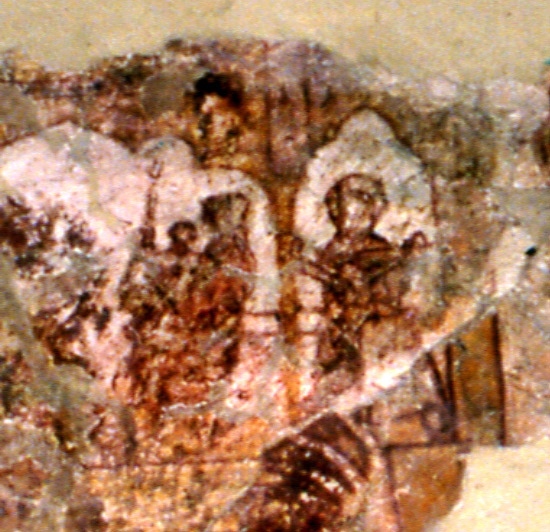Little Kimble, Buckinghamshire (†Oxford) C.14
Man holding a triptych with the Virgin & Child and the Trinity

This very curious and certainly unique painting is on the north wall, above a painting of St Christopher. It shows a figure of a man, probably an ecclesiastic of some kind (there are hints at his neck of the collar of an alb), holding out what appears to be a tablet divided into three scenes. Nearest to the man, whose fingers can be seen fairly clearly, is a representation of the Trinity in a form that became popular in the the later Middle Ages, with God the Father holding the crucified Christ on the Cross in front of him. There are hints of something that may be the Dove of the Holy Spirit above God’s head, and this section of the triptych shows better in the enlarged photograph below.
This way of showing the Trinity is represented on this site by only one other English wall painting, that at Boughton Aluph in Kent. But the Little Kimble example is earlier than that, and this form of the iconography is rare anywhere in western art in the 14th century, and very rare indeed in English wall painting. This example by the Florentine painter Jacopo di Cione and/or his workshop painted about 1370 and now in the National Gallery, London is probably contemporary with the Little Kimble painting.

A painting within a painting, like a play within a play, will always raise questions about meaning. The hint of another figure with a halo, at the left-hand side of this subject is the edge of a painting of St Christopher, one of the many other subjects, not all of them complete or identifiable, in the church. None of which casts any light at all on the real puzzle about this painting – that central question about meaning. The triptych may have been a real artefact – a prized possession of the church, or it may refer to some dogmatic or doctrinal controversy, of which there were many at the end of the fourteenth century in England.
The other paintings in the church, some of which are now on this site, do nothing to shed any light on this one: its meaning and its message are likely to remain a mystery. Tristram was himself puzzled by this image, but he does point out a possible, if tenuous, connection to a poem by John Lydgate, a contemporary of Chaucer and writer of much devotional verse.
The Image of Our Lady
A balad made by Iohn Lydgat of ye ymage of Our Lady.
Beholde and se this glorious fygure,
Whiche Sent Luke of our lady lyvynge
After her lyknes made in picture,
Lo here she is affter the same wyrkynge
As in Rome is had of Saynt Lukes payntynge,
In erthe as she was and her sone also,
And ther honoryd with solempne praysynge
In churche callyd Maria de Populo…
[MSt B.M. Adds. 29729, leaves 9, back, to 10.]
It is far from clear even what Lydgate means by ‘Beholde and se’ here. On the face of it, he is looking at a copy of the miraculous painting attributed to St Luke, of which there must have been many copies – “after the same working”. There is no reason why Lydgate should not have seen such a copy, and that may be all we can say.
I have suspected for some time that the defaced left-hand side of the Little Kimble panel orginally showed a Pietà. Lydgate wrote many devotional poems in honour of the Virgin, and in Image and Devotion in Late Medieval England, John Marks, of the University of York reproduces a late 15th drawing of a Pietà, with a kneeling priest, perhaps intended for Lydgate himself, beside it.
The other paintings in the church and now on-site are St George and St Francis preaching to the birds (there was no place for imagery of any kind in Francis’s belief). Others, including the Martyrdom of St Margaret, and a dubiously identified St Bernard (who had a violent personal antipathy to images of all kinds), are forthcoming.